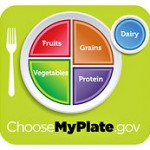In 2010, the US Department of Agriculture, the government body responsible for food recommendations such as the Food Pyramid, has changed its mind about what we should be eating, at least on a daily basis. We got there a long time ago, but we are happy that this is now what is being advertised to all Americans.
Here’s a link to a nice New York Times article explaining it. Here’s a link to the USDA page on the new Food Pyramid, not nearly as helpful as the NYT article, but still worth reading. In the new pyramid, fruits and vegetables occupy a full half of your plate!
As we understand it, the new recommendations for eating are much more balanced than they used to be. Not so many carbs, maybe a little more protein, and much healthier fats. With the new recommendations, nobody becomes overweight.
Many, many thanks to Michele Obama for taking up the cause of obesity as her First-Lady project. She’s right on target for what is needed to help all Americans and citizens of the world eat heathier diets and thereby save us all that Medicare and Medicaid money that we won’t be spending to recuperate from ill health!
Here is the handy way to visualize your eating so you won’t have to memorize anything.
How to Load Up Your Plate
Visually, divide your plate in half. One entire half should be filled with vegetables—cooked or raw, always washed first—and fruits. Salads count here, but you can also pile lots of other fruits and vegetables on this side, too.
Now divide the other half of the plate in half again. Fill one quarter with carbohydrates (potatoes, rice, bread, corn, baked french fries, etc.). One quarter of your plate—that’s it!
Now fill the other quarter with protein (fish, meat, nuts, eggs, cheese, etc.). This portion should be approximately the size of your hand (the solid part, not the fingers). The bigger your hand, the more protein you can eat. So kids, with their little hands, do not ever need to eat a half pound of meat!
We can assume that the protein portion will contain most of the fats in your meal, but there are exceptions, like salad dressing.
Cheese, eggs, and nuts have fat in them, so there’s no need to introduce any other fats. Beef, chicken, and pork meat (and any other animals that you eat) should be trimmed of fats. Here’s the rule: all visible fats removed.
That wouldn’t be very easy with a marbled steak, so this applies to meats that have big chunks of fat hanging off the side. It also says something about marbled steaks (maybe not the best food). Get rid of them and reduce your heart disease risk by half. Remember, heart disease comes in later life but your veins and arteries are accumulating all the way along the fatty deposits that will eventually clog them.
This may sound like a tough rule, but, once you convert to “good fats,” your body will show you how hard the “bad fats” are to digest. By bad fats, we mean animal fat, primarily. But there are also some vegetable fats to avoid.
As we understand it, the following fats are the least good for you, and might be better left in the supermarket: palm oil, cottonseed oil, coconut oil, and lard. Some of them are just plain bad chemical structures for our bodies, and others, cottonseed oil in particular, is so heavily sprayed with pesticides and one can’t imagine how the pesticide residues are eliminated from the oils. For more information, see also our page on Good Fats and Bad Fats.
Try to keep the carb section either light on fats or free of “bad” fats. Remember that carbohydrates are converted to glucose (sugar) by your body. Eating large amounts of carbs will throw off your blood sugar just like a piece of cake. Whole grains slow down this process by releasing the carbohydrates over a longer period, but they will still pack on the pounds.


Hey, you’re the goto expert. Thanks for hanging out here.